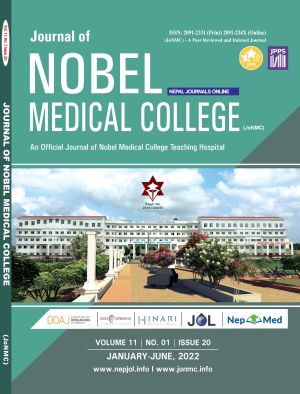Diagnosing Malignancy by Fine Needle Aspiration Cytology in Cases of Solitary Thyroid Nodules
DOI:
https://doi.org/10.3126/jonmc.v11i1.45783Keywords:
Diagnosis, Sensitivity and Specificity, Thyroid NoduleAbstract
Background: A solitary thyroid nodule is a discrete swelling that is palpable in apparently normal thyroid gland. It can be identified clinically as well as radiologically. This study aims to find the prevalence of malignancy in clinically detected solitary thyroid nodule and to compare the findings in pre-operative fine needle aspiration cytology test with post-operative histopathological examination to assess the accuracy of the test.
Materials and Methods: A descriptive cross sectional study was done in patients attending the Otorhinolaryngology outpatient department in our hospital from January to December 2021 with clinically diagnosed solitary thyroid nodules. Ethical approval was taken from the Institutional Review Committee ofNobel Medical College and Teaching Hospital (58412021). The collected data were collected in Microsoft Excel 2013and was analyzed in Statistical Package for the Social Sciences version 21. Point estimate at 95% ConfidenceInterval and descriptive statistics were interpreted as frequency, percentage, or as mean and standarddeviations.
Results: Among 37 patients with clinically detected solitary thyroid nodules, malignancy was found in 12 (32.43%) (17.35-47.51 at 95% Confidence Interval).The mean age of presentation was 34 ± 13 years with male female ratio of 1:8.Fine needle aspiration cytology had 64.00% sensitivity and 75.68% specificity in detecting benign lesions and 100% both in detecting malignancy.
Conclusion: The prevalence of malignancy by fine needle aspiration cytology among clinically detected solitary thyroid nodules was high as compared to other similar studies done in similar settings
Downloads
Downloads
Published
How to Cite
Issue
Section
License

This work is licensed under a Creative Commons Attribution 4.0 International License.
JoNMC applies the Creative Commons Attribution (CC BY) license to works we publish. Under this license, authors retain ownership of the copyright for their content, but they allow anyone to download, reuse, reprint, modify, distribute and/or copy the content as long as the original authors and source are cited.




